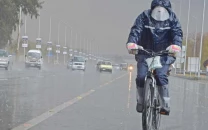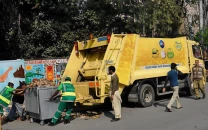Thousands of tourists flock to Jab Valley
Peaceful sites, gushing waterfalls, untouched by commercialisation, enhance its appeal

In a striking display of Pakistan's growing eco-tourism potential, thousands of tourists from across the country flocked to Jab Valley in Haripur during the Eid holidays, turning the once-obscure locale into one of Khyber Pakhtunkhwa's most sought-after destinations.
Located approximately 80 kilometres from Islamabad and 170 kilometres from Peshawar, Jab Valley has quietly evolved into a nature lover's haven, home to a chain of eight waterfalls that cascade in succession through forested cliffs. The valley lies just a short drive from Khanpur Dam, making it a convenient addition to traditional tourist itineraries.
The waterfalls, some plunging from heights of up to 200 metres, were first discovered and documented in 2021 by Hassan Nisar, a YouTuber and founder of Metrix Pakistan. His efforts not only brought the natural beauty of Jab Valley to the forefront but also helped promote the region nationally and internationally through digital media. The viral videos and widespread coverage that followed played a central role in establishing Jab Valley as a new hub for eco-tourism.
"I still remember hiking into the valley for the first time and hearing the roar of the waterfalls echoing through the cliffs. I knew instantly that the world needed to see this," said Nisar, smiling as he watched families pose for photos near the cascading waters. "Today, seeing so many people here appreciating the natural beauty of this place fills me with pride. This is exactly what I dreamed of - tourism that uplifts communities and brings people closer to nature."
He added that Jab Valley now needs targeted government investment and infrastructure development. "With official support, this place can become a signature site of Pakistan's tourism in the new era - a model for sustainable, community-led and eco-friendly travel."
"I came here with my friends from Lahore after seeing a video online. It's nothing like Murree or the usual tourist spots. It's peaceful and untouched," said Areeba Malik, a visitor from Punjab.
Jab Valley's charm lies in its resistance to commercial trappings. With no mega resorts, plastic waste or urban noise, it offers a rare sensory retreat: the gushing of the waterfalls, the call of native birds and the whisper of the wind through towering pine trees and centuries-old wild olive groves, known locally as zaitoon.
The ecological diversity of the region is remarkable. Migratory birds, porcupines, and foxes roam freely, while local flora includes medicinal plants long used by villagers for traditional healing. The valley's discovery has not only enriched Pakistan's natural tourism map. It has also revived the local economy.
Shoukat, a roadside daba owner in the area, credits the influx of tourists for a threefold increase in his daily earnings since 2021. "Before, I used to make around Rs400 a day. Now during peak season or Eid, I can earn up to Rs1,200. That's a big difference for someone like me," he said, flashing a grateful smile.
Despite the growing footfall, infrastructure remains minimal. Access roads are unpaved in sections, and there are no formal visitor facilities beyond a few local tea stalls and makeshift seating areas. While this lack of development adds to the valley's rustic appeal, it also raises questions about sustainability.
Environmentalists caution that without regulated tourism, the fragile ecosystem could suffer. "We need eco-conscious tourism, guided hikes, proper waste disposal and limited human interference," said an environmental science student from Hazara University visiting the site.
For now, Jab Valley remains a rare window into what tourism in Pakistan could be: rooted in nature, sustained by communities and appreciated with reverence.




















COMMENTS
Comments are moderated and generally will be posted if they are on-topic and not abusive.
For more information, please see our Comments FAQ